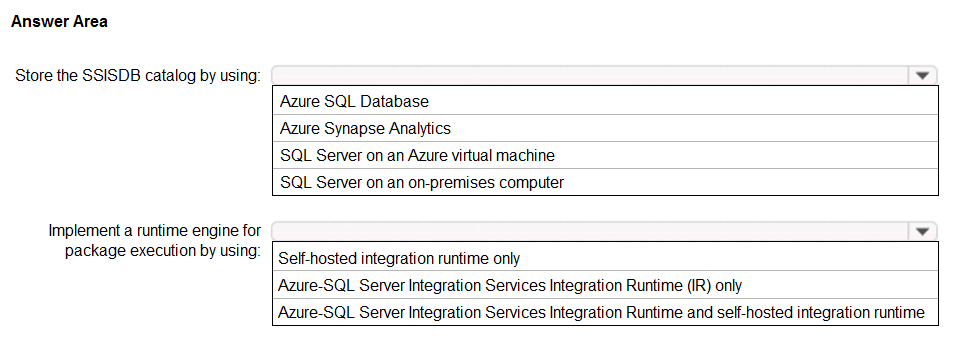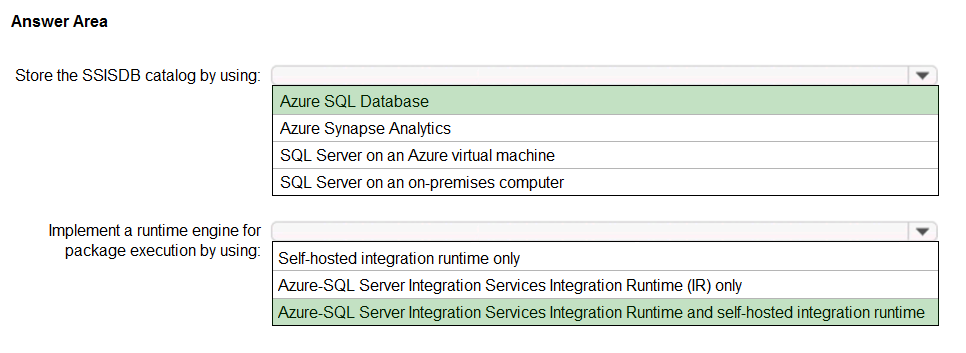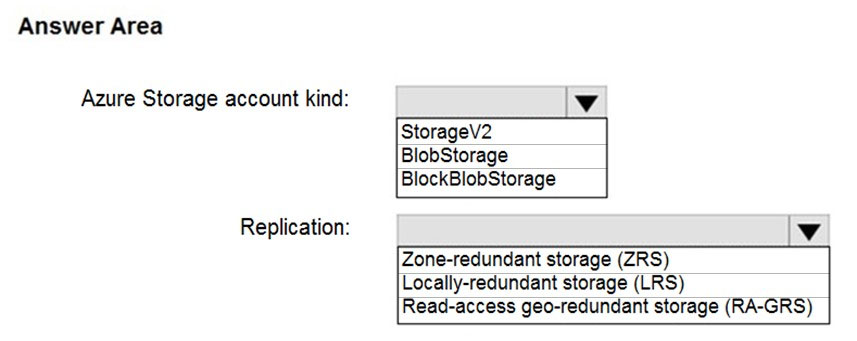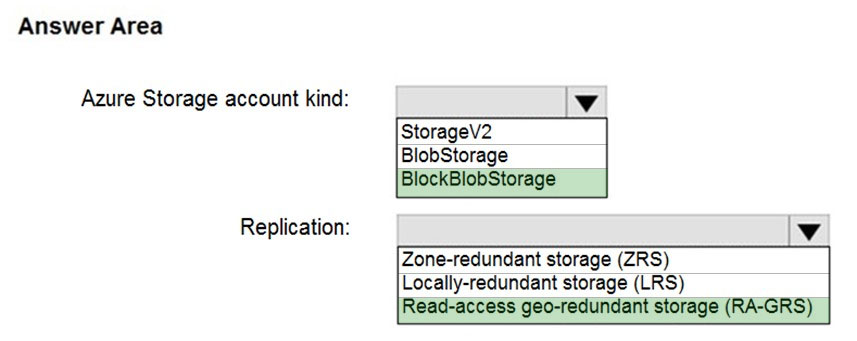Note: This question is part of a series of questions that present the same scenario. Each question in the series contains a unique solution that might meet the stated goals. Some question sets might have more than one correct solution, while others might not have a correct solution.
After you answer a question in this section, you will NOT be able to return to it. As a result, these questions will not appear in the review screen.
You have an Azure Storage account that contains two 1-GB data files named File1 and File2. The data files are set to use the archive access tier.
You need to ensure that File1 is accessible immediately when a retrieval request is initiated.
Solution: You add a new file share to the storage account.
Does this meet the goal?
Answer:
B
Note: This question is part of a series of questions that present the same scenario. Each question in the series contains a unique solution that might meet the stated goals. Some question sets might have more than one correct solution, while others might not have a correct solution.
After you answer a question in this section, you will NOT be able to return to it. As a result, these questions will not appear in the review screen.
You have an Azure Storage account that contains two 1-GB data files named File1 and File2. The data files are set to use the archive access tier.
You need to ensure that File1 is accessible immediately when a retrieval request is initiated.
Solution: You move File1 to a new storage account. For File1, you set Access tier to Archive.
Does this meet the goal?
Answer:
B
Instead use the hot access tier.
The hot access tier has higher storage costs than cool and archive tiers, but the lowest access costs. Example usage scenarios for the hot access tier include:
Data that's in active use or expected to be accessed (read from and written to) frequently.
✑ Data that's staged for processing and eventual migration to the cool access tier.
Reference:
https://docs.microsoft.com/en-us/azure/storage/blobs/storage-blob-storage-tiers
You are designing an order processing system in Azure that will contain the Azure resources shown in the following table.
The order processing system will have the following transaction flow:
✑ A customer will place an order by using App1.
✑ When the order is received, App1 will generate a message to check for product availability at vendor 1 and vendor 2.
✑ An integration component will process the message, and then trigger either Function1 or Function2 depending on the type of order.
✑ Once a vendor confirms the product availability, a status message for App1 will be generated by Function1 or Function2.
✑ All the steps of the transaction will be logged to storage1.
Which type of resource should you recommend for the integration component?
Answer:
A
A data factory can have one or more pipelines. A pipeline is a logical grouping of activities that together perform a task.
The activities in a pipeline define actions to perform on your data.
Data Factory has three groupings of activities: data movement activities, data transformation activities, and control activities.
Azure Functions is now integrated with Azure Data Factory, allowing you to run an Azure function as a step in your data factory pipelines.
Reference:
https://docs.microsoft.com/en-us/azure/data-factory/concepts-pipelines-activities
HOTSPOT -
You have an existing implementation of Microsoft SQL Server Integration Services (SSIS) packages stored in an SSISDB catalog on your on-premises network.
The on-premises network does not have hybrid connectivity to Azure by using Site-to-Site VPN or ExpressRoute.
You want to migrate the packages to Azure Data Factory.
You need to recommend a solution that facilitates the migration while minimizing changes to the existing packages. The solution must minimize costs.
What should you recommend? To answer, select the appropriate options in the answer area.
NOTE: Each correct selection is worth one point.
Hot Area:
Answer:

Box 1: Azure SQL database -
You can't create the SSISDB Catalog database on Azure SQL Database at this time independently of creating the Azure-SSIS Integration Runtime in Azure Data
Factory. The Azure-SSIS IR is the runtime environment that runs SSIS packages on Azure.
Box 2: Azure-SQL Server Integration Service Integration Runtime and self-hosted integration runtime
The Integration Runtime (IR) is the compute infrastructure used by Azure Data Factory to provide data integration capabilities across different network environments. Azure-SSIS Integration Runtime (IR) in Azure Data Factory (ADF) supports running SSIS packages.
Self-hosted integration runtime can be used for data movement in this scenario.
Reference:
https://docs.microsoft.com/en-us/azure/data-factory/create-azure-integration-runtime https://docs.microsoft.com/en-us/sql/integration-services/lift-shift/ssis-azure-connect-to-catalog-database
You have 70 TB of files on your on-premises file server.
You need to recommend solution for importing data to Azure. The solution must minimize cost.
What Azure service should you recommend?
Answer:
C
Microsoft has engineered an extremely powerful solution that helps customers get their data to the Azure public cloud in a cost-effective, secure, and efficient manner with powerful Azure and machine learning at play. The solution is called Data Box.
Data Box and is in general availability status. It is a rugged device that allows organizations to have 100 TB of capacity on which to copy their data and then send it to be transferred to Azure.
Incorrect Answers:
A: StoreSimple would not be able to handle 70 TB of data.
Reference:
https://www.vembu.com/blog/what-is-microsoft-azure-data-box-disk-edge-heavy-gateway-overview/
Note: This question is part of a series of questions that present the same scenario. Each question in the series contains a unique solution that might meet the stated goals. Some question sets might have more than one correct solution, while others might not have a correct solution.
After you answer a question in this section, you will NOT be able to return to it. As a result, these questions will not appear in the review screen.
You are designing an Azure solution for a company that has four departments. Each department will deploy several Azure app services and Azure SQL databases.
You need to recommend a solution to report the costs for each department to deploy the app services and the databases. The solution must provide a consolidated view for cost reporting that displays cost broken down by department.
Solution: Create a separate resource group for each department. Place the resources for each department in its respective resource group.
Does this meet the goal?
Answer:
B
Instead create a resources group for each resource type. Assign tags to each resource group.
Note: Tags enable you to retrieve related resources from different resource groups. This approach is helpful when you need to organize resources for billing or management.
Reference:
https://docs.microsoft.com/en-us/azure/azure-resource-manager/resource-group-using-tags
You have an Azure subscription that contains 100 virtual machines.
You plan to design a data protection strategy to encrypt the virtual disks.
You need to recommend a solution to encrypt the disks by using Azure Disk Encryption. The solution must provide the ability to encrypt operating system disks and data disks.
What should you include in the recommendation?
Answer:
B
For enhanced virtual machine (VM) security and compliance, virtual disks in Azure can be encrypted. Disks are encrypted by using cryptographic keys that are secured in an Azure Key Vault. You control these cryptographic keys and can audit their use.
Reference:
https://docs.microsoft.com/en-us/azure/virtual-machines/windows/encrypt-disks
You have data files in Azure Blob storage.
You plan to transform the files and move them to Azure Data Lake Storage.
You need to transform the data by using mapping data flow.
Which Azure service should you use?
Answer:
C
You can use Copy Activity in Azure Data Factory to copy data from and to Azure Data Lake Storage Gen2, and use Data Flow to transform data in Azure Data
Lake Storage Gen2.
Reference:
https://docs.microsoft.com/en-us/azure/data-factory/connector-azure-data-lake-storage
HOTSPOT -
You plan to develop a new app that will store business critical data. The app must meet the following requirements:
✑ Prevent new data from being modified for one year.
✑ Minimize read latency.
✑ Maximize data resiliency.
You need to recommend a storage solution for the app.
What should you recommend? To answer, select the appropriate options in the answer area.
Hot Area:
Answer:

Box 1:
BlockBlobStorage -
Storage accounts with premium performance characteristics for block blobs and append blobs.
Box 2:
Reference:
https://docs.microsoft.com/en-us/azure/storage/common/storage-account-overview https://docs.microsoft.com/en-us/azure/storage/common/storage-redundancy?toc=/azure/storage/blobs/toc.json
You have an application named App1. App1 generates log files that must be archived for five years. The log files must be readable by App1 but must not be modified.
Which storage solution should you recommend for archiving?
Answer:
B
Immutable storage for Azure Blob storage enables users to store business-critical data objects in a WORM (Write Once, Read Many) state.
Immutable storage supports:
Time-based retention policy support: Users can set policies to store data for a specified interval. When a time-based retention policy is set, blobs can be created and read, but not modified or deleted. After the retention period has expired, blobs can be deleted but not overwritten.
Reference:
https://docs.microsoft.com/en-us/azure/storage/blobs/storage-blob-immutable-storage